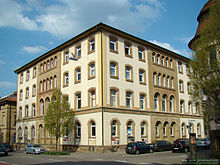Wilhelmsbau (Heilbronn)
The Wilhelmsbau is a listed building at Wilhelmstraße 9 in Heilbronn , which reminds of the once influential Heilbronn entrepreneur family Cluss and has been used by the Heilbronn city administration since 1901.
description
The cultural monument was built by Heinrich Cluss from 1841 to 1845. The building, initially called Clussbau , was then rented to the manufacturers Peter Bruckmann and Emil Seelig and the merchant Friedrich Closs; Another resident, probably from around 1850, was the autograph collector Carl Künzel . The building is part of an entire ensemble on Cäcilienstraße that is reminiscent of the once influential Cluss family . At the western end of the street was the Cluss brewery , founded in 1865 by August Cluss, the youngest son of the builder of the Wilhelmsbau , at the eastern end the daughter Henriette lived with her husband, the sugar factory director and co-founder of the brewery, Andreas Faißt, which is now also a listed building .
It is claimed that the building, which has the Byzantine arched style of the first Stuttgart train station, was planned as a train station hotel. Allegedly in 1840 the planners assumed that a train station would be built in the south of Wilhelmstrasse. However, the building was already completed and occupied when the actual route variants for the first Heilbronn train station were discussed in 1845 .
The common name Wilhelmsbau is derived from the address of the building at Wilhelmstraße 9, at the corner of Cäcilienstraße 45. The building is a fine example of the arched style , a variant of classicism . The listed secular building was built on a square floor plan and was originally three-story. Each floor had two kitchens and twelve heatable rooms.
Heinrich Cluss's heirs sold the building in 1876. A later owner was the Glass piano factory . The city of Heilbronn acquired the building in 1901, has since used it as an administration building and, before the First World War, added a fourth floor to match the rest of the architecture. The building survived the Second World War largely unscathed. In 1950, it contained the offices of Mayor Paul Meyle and Mayor Nägele, the city treasury, the school and spa administration, the registry office, the finance department, the council clerk, the personnel office, the courier, the procurement office, the office for emergency aid, the property office and the auditing office housed. After more official buildings became available due to the reconstruction of the city, only the building authorities use the building in 1961.
The Wilhelmsbau is now a listed building and is therefore a cultural monument .
literature
- Julius Fekete, Simon Haag, Adelheid Hanke, Daniela Naumann: Monument topography Baden-Württemberg . Volume I.5: Heilbronn district. Theiss, Stuttgart 2007, ISBN 978-3-8062-1988-3 , pp. 81 .
Individual evidence
- ^ Emil Michelmann, Carl Künzel. A collector's genius from Swabia , Stuttgart 1938, pp. 8–11
- ^ Bernhard Lattner with texts by Joachim J. Hennze: Stille Zeitzeugen. 500 years of Heilbronn architecture . Edition Lattner, Heilbronn 2005, ISBN 3-9807729-6-9 , page 30
- ^ City of Heilbronn (ed.): Address book of the city of Heilbronn 1950 , Heilbronn 1950.
- ^ City of Heilbronn (ed.): Address book of the city of Heilbronn 1961 , Heilbronn 1961.
Web links
Coordinates: 49 ° 8 ′ 15.1 ″ N , 9 ° 13 ′ 10.8 ″ E

